
USS General A. W. Greely (AP-141) was a General G. O. Squier-class transport ship named for U.S. Army general Adolphus Greely. She was transferred to the U.S. Army as USAT General A. W. Greeley in 1946. On 1 March 1950 she was transferred to the Military Sea Transportation Service (MSTS) as USNS General A. W. Greely (T-AP-141). She was later sold and converted to a container ship and operated under several names before being scrapped in 1986.
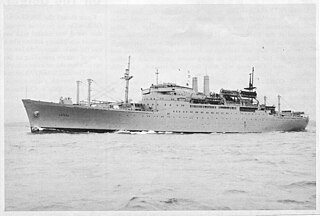
USNS Geiger (T-AP-197)/USTS Bay State IV was a transport ship in the United States Navy. She was named after General Roy Geiger, who, from July 1945 to November 1946, commanded Marine Force, Pacific Fleet.

USS Admiral Hugh Rodman (AP-126) was an Admiral W. S. Benson-class transport: Laid down, 24 April 1944, as a Maritime Commission type (P2-SE2-R1) hull, under Maritime Commission contract,, at Bethlehem Shipbuilding Corporation, Alameda, California; launched on 25 February 1945; commissioned as the USS Admiral Hugh Rodman (AP-126), 7 July 1945, decommissioned on 14 May 1946, at New York; transferred to the U.S. Army Transportation Service in May 1946; commissioned USAT General Maurice Rose on 1 August 1946; reacquired by the U.S. Navy and assigned to the Military Sea Transport Service (MSTS); placed in service as USNS General Maurice Rose (T-AP-126) on 1 March 1950.

USS General George M. Randall (AP-115) was a General John Pope class troop transport which served with the United States Navy in World War II and the postwar era. She was named after Major General George Morton Randall, an American Civil War hero, and veteran of the Indian wars of the 1880s and the Philippines in the early 1900s.

USS General LeRoy Eltinge (AP-154) was a General G. O. Squier-class transport ship for the US Navy in World War II. She was named in honor of US Army general LeRoy Eltinge. She was transferred to the US Army as USAT General LeRoy Eltinge in 1946. On 20 July 1950 she was transferred to the Military Sea Transportation Service (MSTS) as USNS General LeRoy Eltinge (T-AP-154). She was later sold for commercial use and operated under the names SS Robert E. Lee and SS Robert Toombs, before being scrapped in 1980.
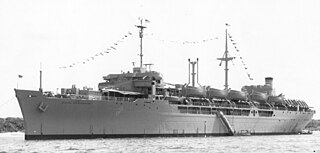
USS General R. M. Blatchford (AP-153) was a General G. O. Squier-class transport ship for the U.S. Navy in World War II. She was named in honor of U.S. Army general Richard M. Blatchford. She was transferred to the U.S. Army as USAT General R. M. Blatchford in 1946. On 1 March 1950 she was transferred to the Military Sea Transportation Service (MSTS) as USNS General R. M. Blatchford (T-AP-153). She was later sold for commercial operation under the names SS Stonewall Jackson and Alex Stephens, before being scrapped in 1980.

USS General W. M. Black (AP-135) was a General G. O. Squier-class transport ship for the U.S. Navy in World War II. The ship was crewed by the U.S. Coast Guard until decommissioning. She was named in honor of U.S. Army general William Murray Black. She was transferred to the U.S. Army as USAT General W. M. Black in 1946. On 1 March 1950 she was transferred to the Military Sea Transportation Service (MSTS) as USNS General W. M. Black (T-AP-135). She was later sold for commercial operation under the name SS Green Forest, before being scrapped in 1980.

USS General S. D. Sturgis (AP-137) was a General G. O. Squier-class transport ship for the U.S. Navy in World War II. She was named in honor of U.S. Army general Samuel Davis Sturgis. She was transferred to the U.S. Army as USAT General S. D. Sturgis in 1946. On 1 March 1950 she was transferred to the Military Sea Transportation Service (MSTS) as USNS General S. D. Sturgis (T-AP-137). She was later sold for commercial operation under the name SS Green Port, before being scrapped in 1980.

USS General M. B. Stewart (AP-140) was a General G. O. Squier-class transport ship for the U.S. Navy in World War II. She was named in honor of U.S. Army general Merch Bradt Stewart. She was transferred to the U.S. Army as USAT General M. B. Stewart in 1946. On 1 March 1950 she was transferred to the Military Sea Transportation Service (MSTS) as USNS General M. B. Stewart (T-AP-140). She was later sold for commercial operation under the name SS Albany, before being scrapped in July 1987.

USS General M. M. Patrick (AP-150) was a General G. O. Squier-class transport ship built for the US Navy in World War II. She was named in honor of US Army general Mason Mathews Patrick, a graduate of the US Military Academy in 1886. Promoted to major general in 1918, during World War I, he was appointed Chief of the Army Air Service, the position he held until his retirement in 1927. After the Armistice, he represented the A.E.F. at the Paris Peace Conference.

USS General M. L. Hersey (AP-148) was a General G. O. Squier-class transport ship of the U.S. Navy in World War II. She was named in honor of U.S. Army general Mark Leslie Hersey. She was transferred to the U.S. Army as USAT General M. L. Hersey in 1946. On 1 March 1950 she was transferred to the Military Sea Transportation Service (MSTS) as USNS General M. L. Hersey (T-AP-148). She was later sold for commercial use, and operated under the names SS Pittsburgh and SS St. Louis.
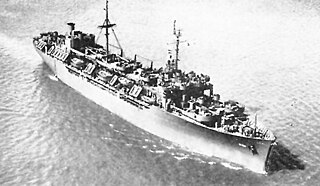
USS General W. C. Langfitt (AP-151) was a General G. O. Squier-class transport ship for the U.S. Navy in World War II. She was named in honor of U.S. Army general William Campbell Langfitt. She was transferred to the U.S. Army as USAT General W. C. Langfitt in 1946. On 1 March 1950 she was transferred to the Military Sea Transportation Service (MSTS) as USNS General W. C. Langfitt (T-AP-151). She was later sold for commercial operation under the name SS Transindiana, before ultimately being scrapped in 1983.

USS General John Pope (AP-110) was a troop transport that served with the United States Navy in World War II. After the war she was transferred to the Army and redesignated USAT General John Pope. She later served in the Korean and Vietnam Wars as a civilian-manned Military Sea Transportation Service vessel, as USNS General John Pope (T-AP-110).

USS General W. H. Gordon (AP-117) was a troop transport that served with the United States Navy in World War II. After the war, she was transferred to the US Army and served as USAT General W. H. Gordon. In the mid to late 1940s she sailed in trans-Pacific American President Lines passenger service with sister ship SS General Meigs. With the outbreak of the Korean War, she was reacquired by the Navy as a civilian-manned Military Sea Transportation Service (MSTS) vessel, and redesignated USNS General W. H. Gordon (T-AP-117). She served again under the same designation in the Vietnam War.
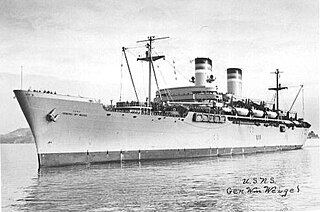
USS General William Weigel (AP-119) was a troopship that served with the United States Navy in World War II. After the war, she was acquired by the US Army and became USAT General William Weigel. On the outbreak of the Korean War, she was transferred to the Military Sea Transportation Service (MSTS) and designated USNS General William Weigel (T-AP-119), a designation she retained for her later service in the Vietnam War.
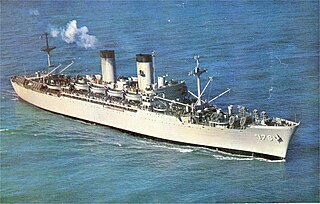
USS General J. C. Breckinridge (AP-176) was a troopship that served with the United States Navy in World War II, the Korean War and the Vietnam War. In October 1949 she was redesignated T-AP-176 but retained her Navy crew. Her namesake was United States Marine Corps Lieutenant General James Carson Breckinridge (1877-1942), who was the grandson of John Cabell Breckinridge, who served as Vice President of the United States from 1857 to 1861.
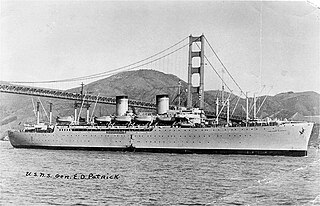
USS Admiral C. F. Hughes (AP-124) was a Admiral W. S. Benson-class transport named in honor of Charles Frederick Hughes, an admiral in the United States Navy who served as Chief of Naval Operations from 1927 to 1930. It was later renamed the ship USAT General Edwin D. Patrick after Edwin D. Patrick, an Army general who died in World War II.
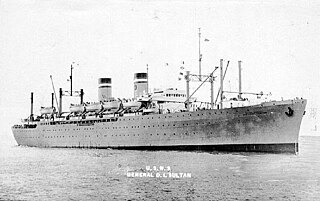
USS Admiral W. S. Benson (AP-120) began as an unnamed transport, AP-120, that was laid down on 10 December 1942 at Alameda, California by the Bethlehem-Alameda Shipbuilding Corp., under a Maritime Commission contract. She was named Admiral W. S. Benson (AP-120) on 20 October 1943 and launched on 22 November 1943; sponsored by Miss Dorothy Lucille Benson, granddaughter of the late Admiral William S. Benson. She was accepted from the Maritime Commission on 23 August 1944 and commissioned the same day.
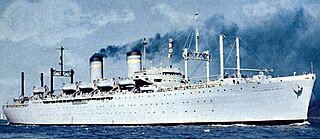
USS Admiral R. E. Coontz (AP-122) was an Admiral W. S. Benson-class transport built for the U.S. Navy during World War II. She was laid down under a Maritime Commission contract on 15 January 1943 at Alameda, California, by the Bethlehem Steel Corp., and launched on 22 April 1944. She was sponsored by Mrs. Edwin Kokko, daughter of Admiral Coontz, and commissioned on 21 November 1944, Capt. Montford R. Tawes, USNR, in command.

USS Admiral E. W. Eberle (AP-123) was laid down on 15 February 1943 under a Maritime Commission contract by the Bethlehem Shipbuilding Corporation, Alameda, California; launched on 14 June 1944; sponsored by Mrs. Earl Warren, the wife of the Governor of California who later became Chief Justice of the United States Supreme Court; and acquired by the Navy and commissioned on 24 January 1945, Capt. G. C. Carlstedt, USCG, in command.





















